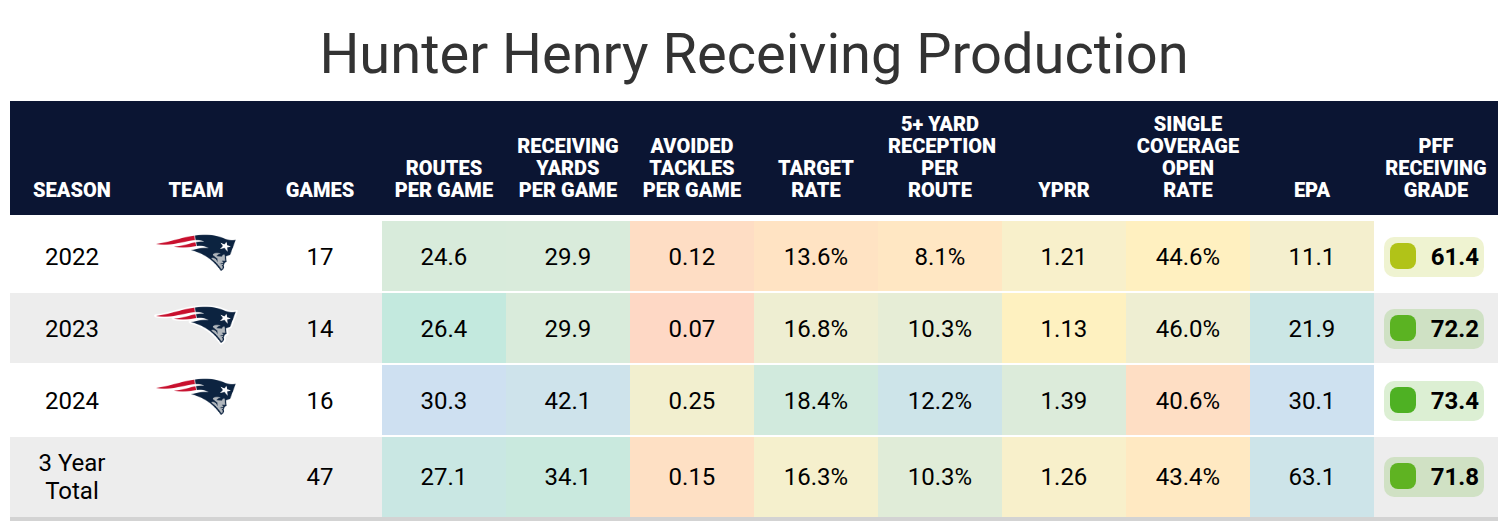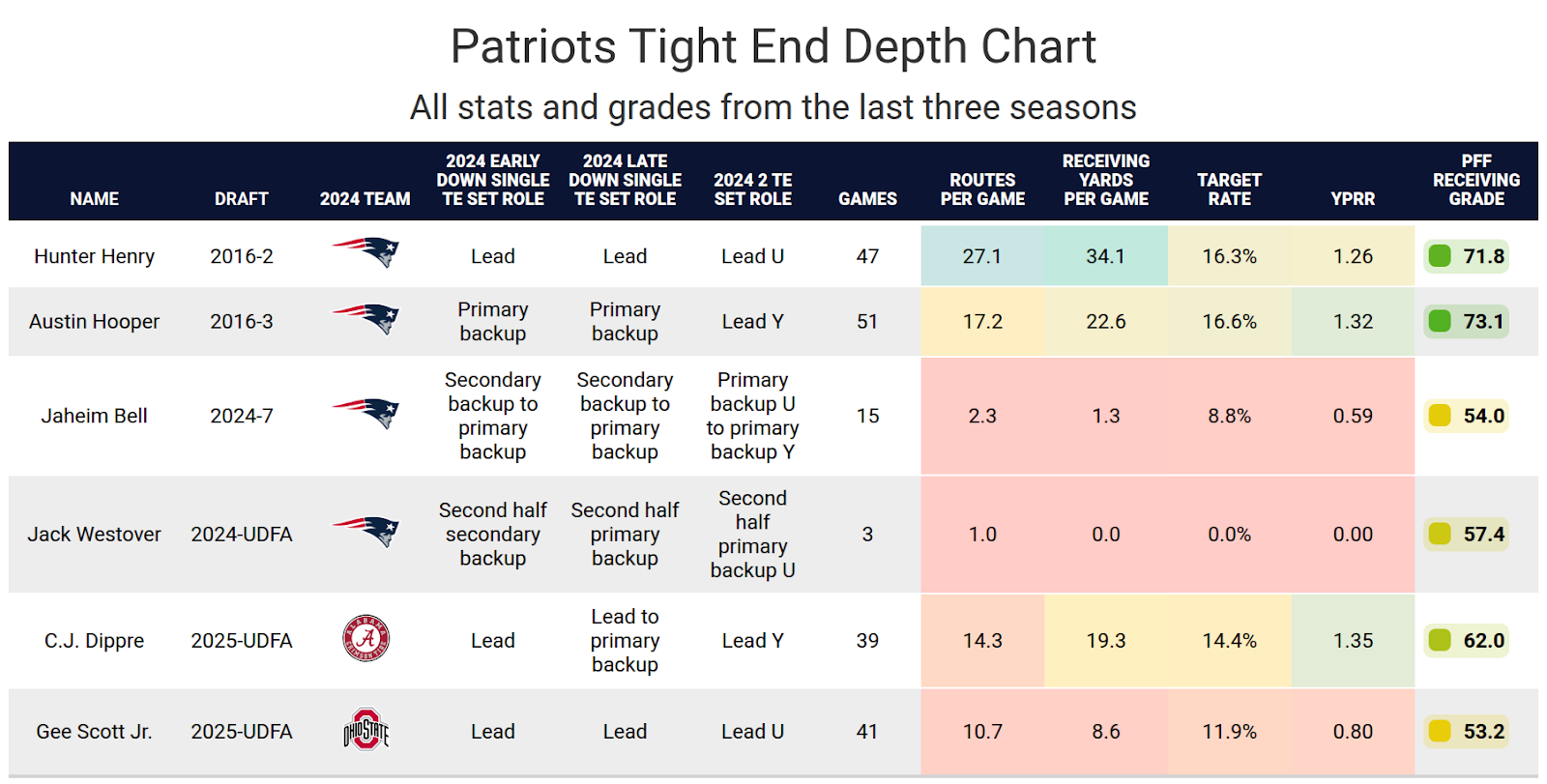
- Hunter Henry has shown flashes of fantasy stardom: Henry has had three weeks as a top-two fantasy tight end over the last two seasons.
- New England Patriots increased target competition: In 2025, Henry faces increased competition for targets, especially with the Stefon Diggs addition, which may limit his consistency and overall fantasy output.
- Subscribe to PFF+: Get access to player grades, PFF Premium Stats, fantasy football rankings, all of the PFF fantasy draft research tools and more!
Estimated Reading Time: 5 minutes

PFF’s Fantasy Football Player Profile series delivers the most in-depth fantasy football analysis available for the 2025 season.
Using PFF’s exclusive data, we evaluate player performance, competition for touches and how teammates and coaching staffs
Last updated: 7:15 a.m. Thursday, June 19
Player performance
Hunter Henry has spent nearly a decade in the NFL, playing five years with the Los Angeles Chargers, and this will be his fifth year with the New England Patriots. Henry was a rotational tight end in his rookie season and sat out another with injury, but in the other three, Henry was a fantasy starter. He ranked somewhere between eighth to 11th with 9.1 to 12.5 points per game. Henry seemed like the next great tight end in the league after his first two seasons, finishing with 83.7 and 87.2 PFF receiving grades, but he was never the same after his injury. His receiving grade has largely fluctuated between 67.4-75.0, outside of a down season in 2022.
He continued being a fantasy starter in his first season with the Patriots, largely thanks to a career-high nine touchdowns. Henry had a down 2022 season but rebounded in 2023. He finished 16th in fantasy points per game in both 2023 and 2024. He has graded moderately well, as he has throughout his career. In 2024, he ran more routes each week and gained more yards, finishing with a higher target rate. However, he was open less often.
Henry has shown signs of greatness in the last two seasons, which have caught the eye of fantasy managers. He gained at least 50 yards and a touchdown in the first two weeks of 2023 and caught 10 passes for 106 yards and three touchdowns in his final two games. He averaged 4.8 fantasy points per game for the 11 weeks in between. In 2024, he had two games with eight receptions each, one resulting in 109 yards and the other with 92. However, he had seven games with 6.5 PPR points or less. In each of the last three seasons, he’s finished outside of the top 18 fantasy tight ends in at least half of his games.
This has made Henry a fine bye week replacement, or an option for a fantasy starter in 14- or 16-team leagues, but at this point, we shouldn’t expect Henry to play notably better than past years, given he’s 30 years old. When deciding which tight ends to draft, if you’re not drafting Henry to be your starter, it probably makes sense to pick a tight end with more upside, even if Henry is projected to score more points.


Projected role
Henry’s role has been a lead tight end, as his playing time has notably increased last season. His primary competition has been Austin Hooper, who is similarly a long-time veteran with a history as a receiving tight end. Hooper has graded better as a receiver, but Henry was the primary tight end last season. They similarly kept their other backup tight ends, but they barely received any playing time last season.
We should expect Henry and Hooper to share the tight end room again this season, where both play in two tight end sets and Henry plays the majority of snaps in single tight end sets.
Henry’s target share has been rising each season, but part of that has been due to a lack of competition for targets. New England added Stefon Diggs and Mack Hollins in free agency, Kyle Williams in the draft and retained all of their top wide receivers from the end of last season. They also added TreVeyon Henderson at running back to likely be their new receiving back. This can only lead to a decrease in Henry’s target share.


Impact of teammates
The Patriots changed coaching staffs this season, bringing in Mike Vrabel as head coach and Josh McDaniels as offensive coordinator. McDaniels spent 2012-2021 as the Patriots’ offensive coordinator, overlapping with Henry’s first season with the Patriots. That was the year Henry scored nine touchdowns. That season, Henry had a very high target rate when the Patriots were close to scoring, but he didn’t necessarily run more routes. McDaniels generally has a tight end with a high target rate near the end zone, but no one was higher than Henry’s rate in 2021, which includes several seasons with Rob Gronkowski. None of the Patriots’ wide receivers has the size to be a specific red-zone threat. The only one that’s close is Mack Hollins, who played in McDaniels’ offense in 2022 and only scored four touchdowns. This suggests Henry could score more touchdowns this season. On the downside, Henry only played 68% of New England’s offensive snaps that season compared to at least 75% each of the past three seasons.
Henry isn’t the only tight end with a history with McDaniels, as Austin Hooper played for McDaniels in 2023 with the Las Vegas Raiders and played for Vrabel in 2022 with the Tennessee Titans. Hooper’s role on both teams was as a receiving specialist. With the Raiders, rookie Michael Mayer played more snaps in the first eight weeks, but Hooper ran nearly as many routes and earned more receptions. Once McDaniels was fired, Mayer had more receptions over the rest of the season. In 2022, Geoff Swaim led the tight end room in snaps, and Chig Okonkwo was the more effective tight end, but Hooper dominated third-down snaps and led the team in receiving yards.
This suggests that Henry will play fewer snaps, while Hooper is on the field more often than last season. The decrease in snaps mixed with more touchdowns will make Henry even less consistent or predictable.
Henry will be catching passes from Drake Maye for a second straight season. The biggest reason to be optimistic about Henry this season is Maye’s potential improvement. However, Maye already had an excellent short accuracy rate and a high rate of throwing to tight ends, so if Maye improves, it will probably involve more passes to wide receivers. Nonetheless, Maye had a high rate of taking sacks and scrambling, where, ideally, a higher percentage of his dropbacks turn into passes. This is the improvement by Maye that would best lead to an increase in fantasy production for Henry.


Bottom line
Hunter Henry is a fine tight end option for anyone in a 14- or 16-team league and wants to wait at the tight end position, but for anyone looking for a backup in a 10- or 12-team league, they should likely pick a younger, high-upside option than Henry with his limited ceiling.

Footnotes
- Statistics in tables and charts were chosen based on their ability to predict future fantasy performance on a per-game or per-opportunity basis or to describe the player relative to others at the same position.
- “Opportunities” are defined as passing dropbacks, rushing attempts and routes run as a receiver.
- Numbers are provided either by season or based on the past three years. For rookies, only college statistics are included. For non-rookies, only NFL statistics are considered, regardless of whether they played in college within the previous three years.
- As college competition is easier than NFL competition, most rookies are likely to see a decline from their historical numbers.
- Only FBS data is considered for college players and comparisons.
- Kneel-downs are removed from rushing data to provide cleaner quarterback rushing rate statistics.
- The table colors in this article range from blue (indicating good/high) to red (indicating bad/low).
- All percentiles and color codings compare the given player to others with a high sample of opportunities. Generally, the cutoff is one-third of the possible opportunities in the sample. If a player does not meet the threshold, they are still included in the comparison, though their results may appear better or worse than expected due to the smaller, less predictive sample size.
- Information on utilization classifications and their importance can be found here for running backs, wide receivers and tight ends.
This news was originally published on this post .






Be the first to leave a comment